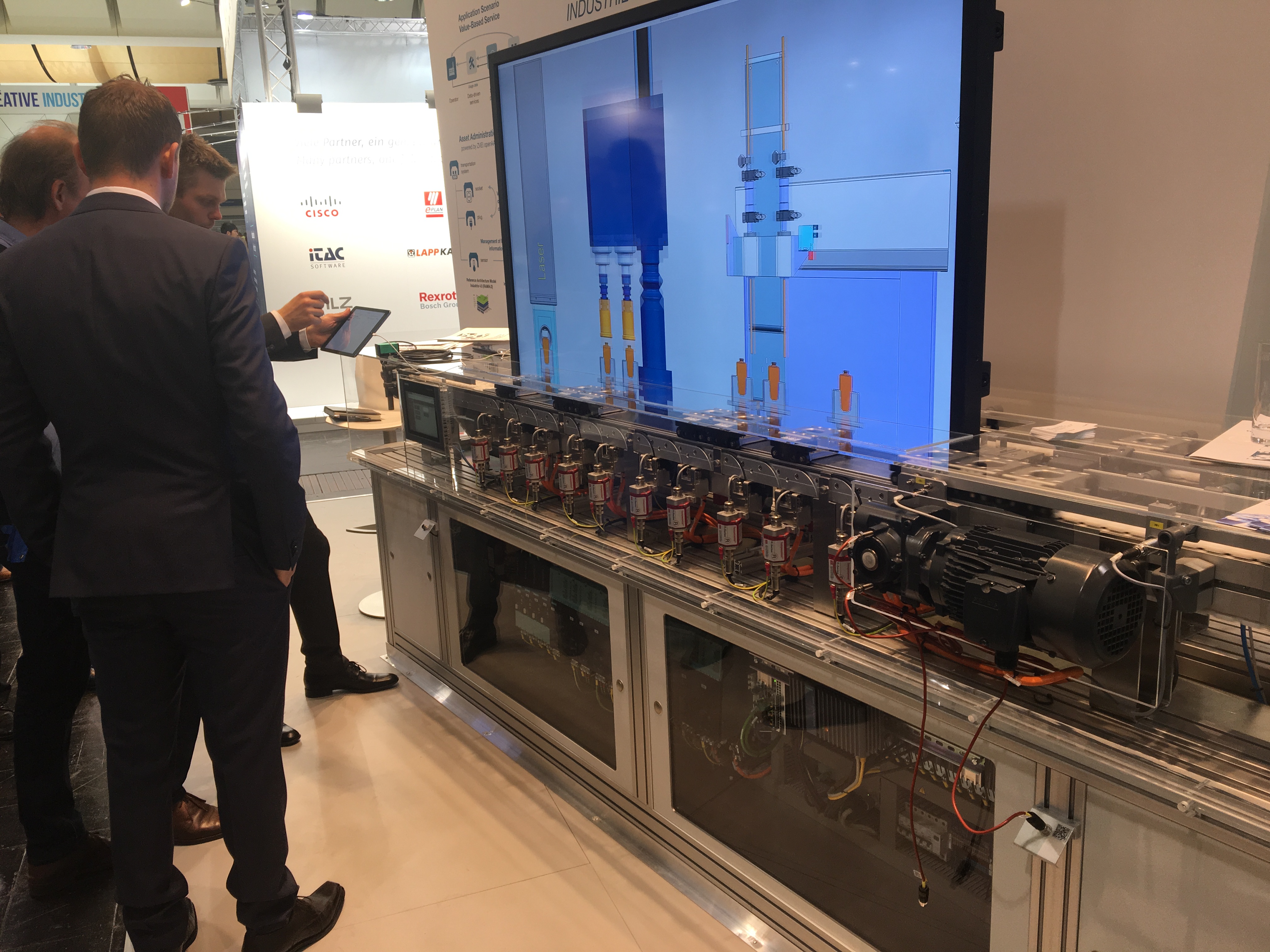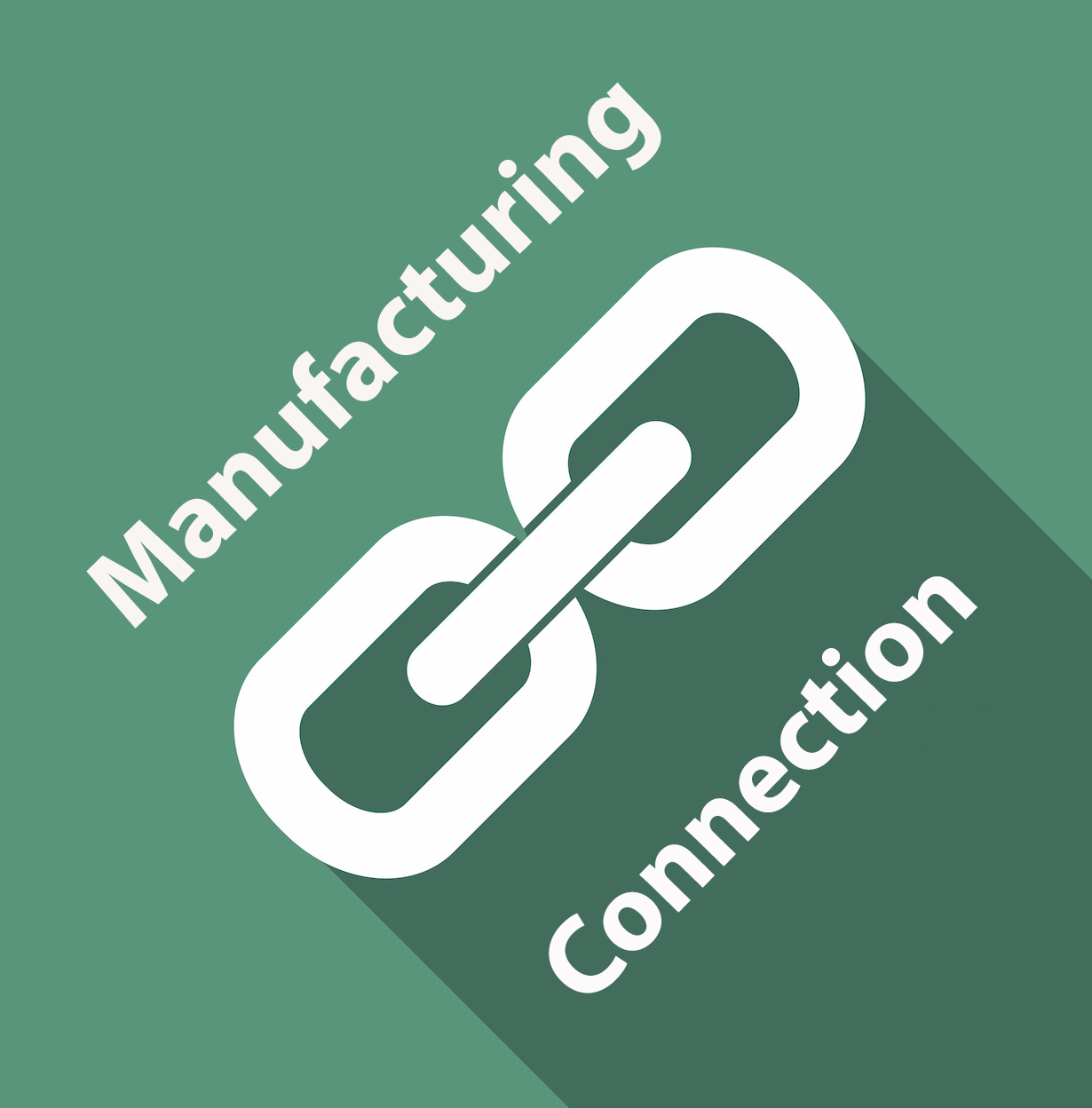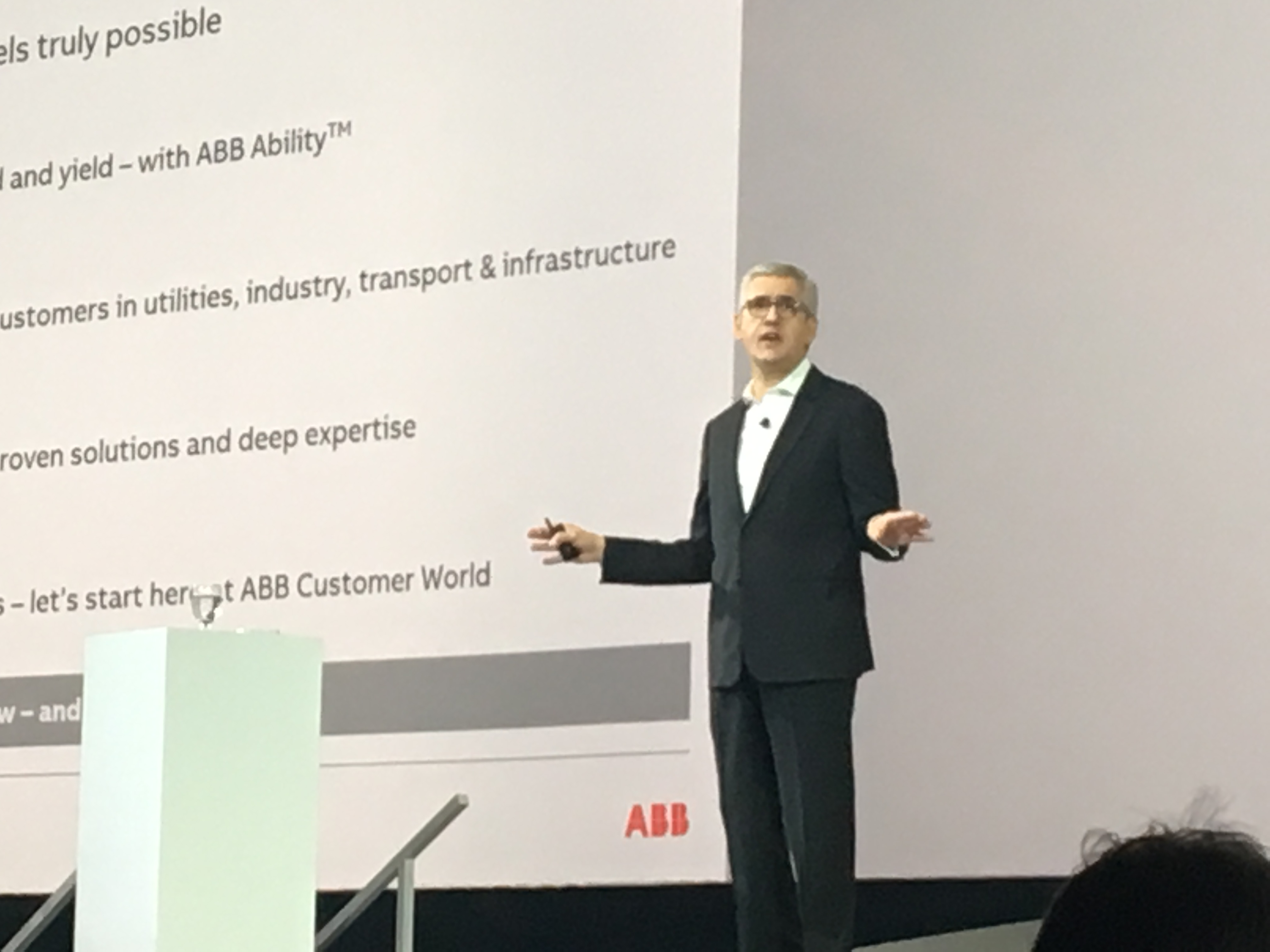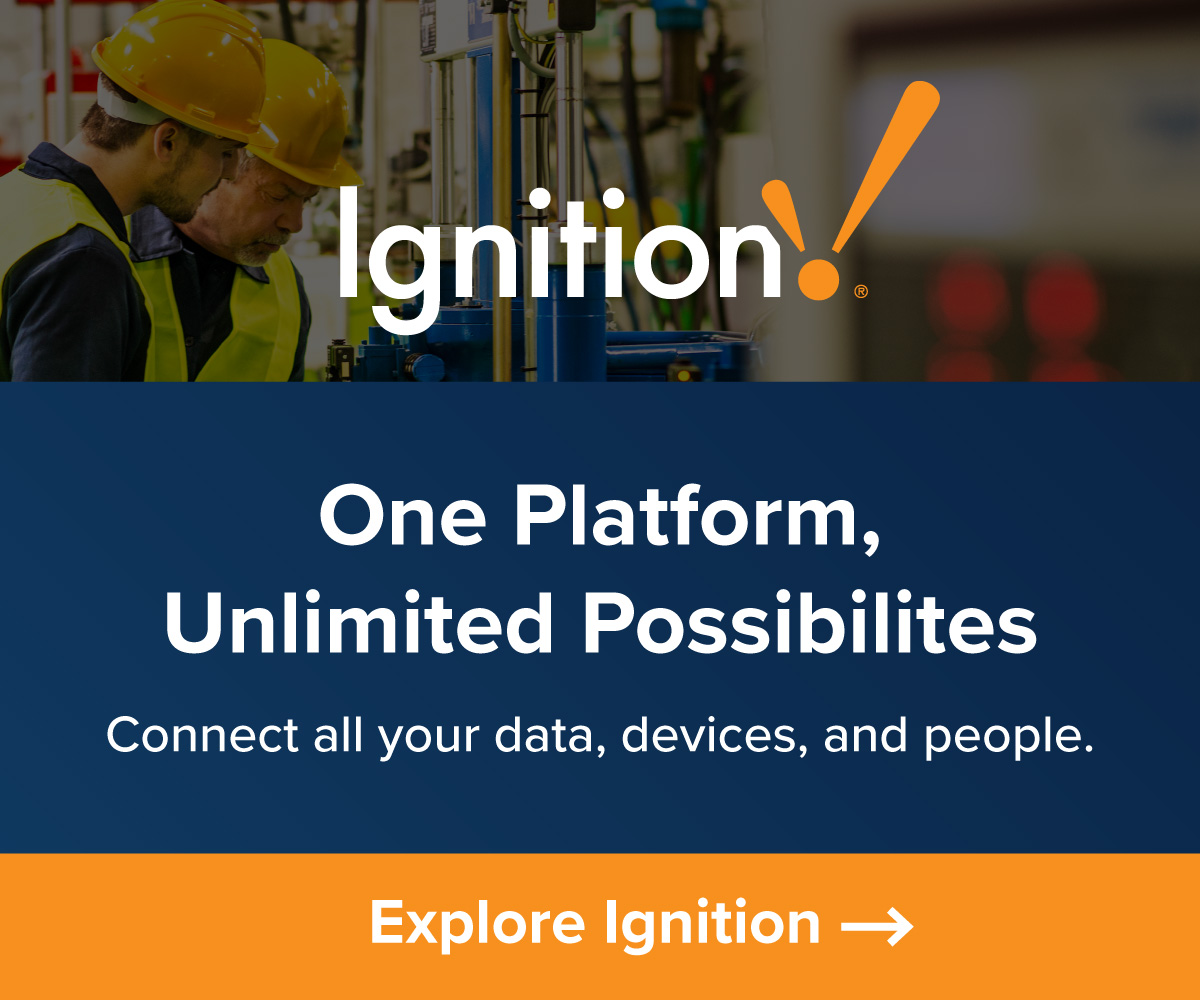
by Gary Mintchell | Apr 25, 2017 | Automation, Internet of Things, Operations Management

Let’s talk augmented reality and Internet of Things (IoT) today.
The first day of Hannover Fair began with much buzz about the Dell / Linux Foundation announcement (see yesterday’s post) about the open source “unify the IoT” project. But that buzz died off after people digested the news and determined that for the time being it was not going to disrupt the industrial world.
I have only a little time between appointments today, so I’ll do a quick recap of some highlights.
OPC Foundation has brought me along to investigate and write about what’s happening with OPC UA and especially with Time Sensitive Networks (TSN). This will not be easy–I see the OPC Foundation logo everywhere. More on this later.
I devoted much time to the Microsoft stand yesterday and again already today. It had the “OPC wall” showing a number of products serving OPC data. Microsoft’s play is moving OPC UA to the Azure cloud. It also showed integration with Time Series Insights, a real-time data base. It also has an IoT suite and recently added IoT Central which is an SaaS application that walks customers through the process of setting up analysis and visualization of the operations data through the OPC UA connection to Azure.

Microsoft had many partners showing authentic working applications of its Hololense augmented reality product–mostly for the enhancement of service technicians including TetraPak and Thyssen Krupp among others.
SAP took me for a walk around its IoT wall. It is building a system where, if all other suppliers opt in and put all their documentation and data into the SAP cloud, then it can serve up a variety of operations and predictive information to operators and maintenance.
ABB announced a partnership with IBM Watson to help customers improve productivity.
Parker has brought all of its products into a network uniquely called Voice of the Machine–an interesting take on IoT.
There’s more, but I’m late for another appointment.

by Gary Mintchell | Apr 12, 2017 | Internet of Things, Operations Management
I received report recently from Altizon (www.altizon.com). It is an interesting look at some Industrial Internet of Things implementations.
The distribution of projects was (out of 62 companies reporting):
• Condition based maintenance 30
• Productivity improvement 62
• Quality Improvement 10
• Energy optimization 35
• Warehouse management 5
• Predictive maintenance 12
• EHS 1
They then looked at overall benefits that their customers derived so far from Industrial Internet of Things projects. The results were distributed with average and spread noted:
• Average Improvement in Topline 5% (3%-8%)
• Average Improvement in Productivity 13% (7% – 50%)
• Savings in Energy Expenses 5% (1%-8%)
• Savings in Indirect Cost 15% (1%-20%)
• Savings in Tooling and Spares Cost 3% (0.5%-6%)
These are interesting numbers. All the companies were implementing productivity improvement projects. Two-thirds also were upgrading maintenance strategies. This showed in an average of 13% improvement in productivity with at least one actually showing a 50% improvement (maybe we don’t want to benchmark the “before”).
I don’t know what they included in indirect costs. But I’m intrigued by the improvement in top line of 5%. This must be from better communication from customer to manufacturing. Certainly that’s an IioT program worth going for.
Altizon works in a number of industries. They looked at trends among their customers in the various industries. Following are highlights.
Trends
Automotive—Move towards a connected Supply chain: Visibility into a supplier’s manufacturing process, in-transit visibility, and management of inventory.
Industrial Products—End-to-end process traceability and Genealogy: if a product fails, it can be traced back to the conditions under which the product was built and the components that constitute the product, right down to the vendor.
Steel Industry—Genealogy and Process traceability-from mining to distribution; environmental management and adoption of ISO 50001.
Tire Industry—Reconciliation of real-time production booking with planned data in ERP systems; environmental management and adoption of ISO 50001.
Food and Consumer Goods—Genealogy and process traceability; performance benchmarking within and across plants.
Chemical Industry—Predicting quality and process yield based on detailed analysis of raw material used; IoT enabled system’s safety.
If you are planning an Internet of Things program and researching potential projects and benefits, these findings would be valuable toward the success of your proposal.

by Gary Mintchell | Mar 17, 2017 | Automation, Data Management, News, Organizations, Process Control, Technology

ABB CEO Ulrich Spiesshofer
ABB held its customer conference in Houston this week and showcased many new products and unveiled its digital enterprise platform ABB Ability.
ABB Ability is the name given to its portfolio of digital solutions. I was trying to place it into a competitive landscape when one speaker showed a slide positioning ABB Ability with GE Predix, Siemens Mindsphere, and Schneider Electric’s Ecostruxure. CEO Ulrich Spiesshofer likened it to putting all the Lego blocks of ABB’s digital offerings together.

ABB Chief Digital Officer Guido Jauret
ABB Ability is a platform, database, and analytics that allows such things as helping customers in utilities, industry, transport and infrastructure develop new processes and advance existing ones by providing insights and optimizing planning and controls for real-time operations. The results can then be fed into control systems to improve key metrics such as factory uptime, speed and yield.
“As a pioneering technology leader in digital solutions, with an installed base of more than 70 million connected devices and 70,000 control systems, ABB is uniquely positioned to support its customers’ digital transformation,” said Spiesshofer. “With ABB Ability, we are combining ABB’s entire portfolio of digital solutions and services. We are creating additional customer value by bringing together ABB’s domain expertise, advanced connectivity and the latest digital technologies. With this, our customers can achieve unprecedented improvements in operational performance and productivity.”
Digital offerings provided by ABB Ability include performance management solutions for asset-intensive industries; control systems for process industries; remote monitoring services for robots, motors and machinery; and control solutions for buildings, electric-vehicle charging networks and offshore platforms. Some of the more specialized offerings address energy management for data centers and navigation optimization for maritime shipping fleets, among many others.
Customers who are already using the portfolio of digital solutions that are now part of ABB Ability include some of the world’s leading utilities, manufacturers and service providers, among them Shell Oil, CenterPoint Energy, Con Edison, BASF, Royal Caribbean, Cargill, Volvo, BMW and many others.
“Building our solutions on the Azure platform means we can take advantage of all of its capabilities and add value with our domain-specific offering,” said ABB Chief Digital Officer Guido Jouret. “In effect, we are turning ABB’s decades of industrial domain expertise into software offerings that our customers can access through the world’s largest and most advanced digital platform. From being a hidden digital champion, we are becoming the partner of choice for customers embarking on a digital transformation. They can now know more, do more, do better, together. We can help them assess, automate, optimize and collaborate.”
 This product was the coolest thing at the show for me. It is ABB’s take on the trend toward smaller I/O devices with configurable racks. Admittedly not having first-mover advantage, ABB was able to build on existing competitive offerings and release an updated take on the technology.
This product was the coolest thing at the show for me. It is ABB’s take on the trend toward smaller I/O devices with configurable racks. Admittedly not having first-mover advantage, ABB was able to build on existing competitive offerings and release an updated take on the technology.
 ABB Ability System 800xA Select I/O, a new addition to System 800xA, is a redundant, Ethernet-based, single-channel I/O system. It supports ABB’s next-generation project execution model, Intelligent Projects, which offers a range of efficiency improvements for automation projects. With Select I/O, customers can undertake major projects on a faster schedule with fewer cost overruns. It uses standardized cabinets that allow installers to digitally marshal signals instead of using labor-intensive marshalling panels. Loop checks can be done before the rest of the system is delivered, minimizing the impact of late changes and allowing for project tasks to be executed in parallel.
ABB Ability System 800xA Select I/O, a new addition to System 800xA, is a redundant, Ethernet-based, single-channel I/O system. It supports ABB’s next-generation project execution model, Intelligent Projects, which offers a range of efficiency improvements for automation projects. With Select I/O, customers can undertake major projects on a faster schedule with fewer cost overruns. It uses standardized cabinets that allow installers to digitally marshal signals instead of using labor-intensive marshalling panels. Loop checks can be done before the rest of the system is delivered, minimizing the impact of late changes and allowing for project tasks to be executed in parallel.
ABB Ability Asset Health Center – Among the first ABB Ability solutions to be launched on Azure is ABB’s next-generation asset performance management solution, Asset Health Center 3.0. Available since January 2017, it uses predictive and prescriptive analytics and customized models to identify and prioritize emerging maintenance needs based on probability of failure and asset criticality.
ABB Ability Collaborative Operations – This powerful solution, now being brought to scale across industries, helps customers collaborate more effectively. It allows experts to work together across organization boundaries, using the same data and analytics platforms. It focuses on such outcomes as improving productivity, reducing equipment failures, lowering the cost of asset maintenance and transforming overall business performance. This is done while maximizing security and protecting data, people and assets at every level of integration. The solution has been delivering sustainable, long-term results to early adopters.
ABB Ability Digital Substation – ABB’s digital substation provides customers in the utility sector with unmatched control and efficiency. The digital substation incorporates fiber optic current sensors and disconnecting circuit breakers to reduce maintenance requirements and the need for miles of conventional cabling. ABB Ability takes these advances several steps further by combining the latest electrical gear with digital sensors and cloud computing. The result is that grid operators can make decisions based on comprehensive, up-to-the-moment information, while predictive algorithms can improve maintenance practices and asset management.
ABB Ability Smart Sensor – This smart sensor solution, unveiled last year, connects low-voltage electric motors to the Industrial Internet, allowing them to be monitored continuously. The solution, which can be easily affixed to a motor, transmits data on vibration, temperature, loads and power consumption to the cloud. Alerts are generated as soon as any of the parameters deviates from the norm, allowing the operator to take preventive action before the motor malfunctions. Early indications are that the smart sensor solution leads to a reduction in downtime of motors by up to 70 percent and extends their lifespan by up to 30 percent. Acting on the data to optimize the motor’s performance reduces energy consumption by as much as 10 percent.

by Gary Mintchell | Nov 16, 2016 | Manufacturing IT, Operations Management, Software
The major manufacturing management software trend of the year is modular. Let’s make it easier to buy, install, configure, and use. The latest company with a major upgrade is Parsec. The company has announced launch of the latest version of its modular manufacturing management software: TrakSYS. A unified, 100% web-based platform with multiple, fully-integrated modules, TrakSYS can be used as a full manufacturing execution system (MES), or deployed to solve one or more business challenges — from performance and quality to e-records, maintenance, workflow, and more.
TrakSYS gathers critical operations data from machines and people, and delivers insights to help operations run more productively, safely and profitably. Leveraging 30 years of experience in delivering manufacturing solutions, Parsec designed this version of TrakSYS to simplify manufacturing operations in a variety of industries – from pharmaceutical and packaged goods to food and beverage, automotive and more.
“Manufacturing is complex, but your software shouldn’t be,” said Eddy Azad, CEO for Parsec. “The key advantage of TrakSYS lies in its flexibility. TrakSYS has all of the power of traditional MES, without the ‘weight’ and cost. Manufacturers can simply turn on the features they want at any time and customize a solution that specifically addresses their needs.”
Manufacturing Management – Simplified
Under the strain of increased regulations for accurate, accessible electronic recordkeeping, manufacturers need a real-time view of manufacturing operations. The pressure to increase quality and quantity, while reducing costs, also has manufacturers seeking a deeper understanding of trends and patterns and new ways to drive efficiency. Custom software and traditional MES solutions can be used to address these concerns, but they are costly and complicated to manage.
Azad, explains, “It’s all about making software easier to use and more cost-effective to deploy, maintain and scale.”
One Platform, Many Applications
TrakSYS is an integrated platform that contains all of the functionality in one package. The modular nature of TrakSYS brings complete flexibility to deploy only the functions that are required, without a major software upgrade. TrakSYS business solutions include OEE, SPC, e-records, maintenance, traceability, workflow, batch processing, sustainability, labor and more.
“Whether a factory has one line or 100, uses manual or automated production processes, relies on PLCs or an IIoT infrastructure, TrakSYS can help. We designed this powerful version of our proven software with the idea that software should help manufacturers to do their job, not become the job,” added Azad.
The latest version of TrakSYS is now available.

by Gary Mintchell | Oct 31, 2016 | Automation, News, Safety, Software, Technology
I have a little batch of process automation and industry news involving predictive technologies—two acquisitions and a new safety product. Congratulations to Mike Brooks and the team at Mtell for a good exit. Also congratulations to the MaxEAM folks. Finally, an important new take on process automation safety from PAS.
MTell Acquired by Aspen Technology
Aspen Technology Inc., a provider of software and services to the process industries, announced it has acquired Mtelligence Corp. (known as Mtell), a San Diego, California-based pioneer in the field of predictive and prescriptive maintenance for asset performance optimization.
Mtell products enable companies to increase asset utilization and avoid unplanned downtime by accurately predicting when equipment failures will occur, understanding why they will occur, and prescribing what to do to avoid the failure.
The products provide a low-touch, rapidly deployable, end-to-end solution that combines a deep understanding of operations and maintenance processes, real-time and historical equipment data and cutting-edge machine learning technologies. As a result, customers can:
- Monitor the health of equipment, detect early failure symptoms, diagnose their root-cause and recommend the best responses to avoid the failure
- Continually learn and automatically adapt to changing equipment and process behaviors
- Automatically share findings across a network of similar equipment to improve the overall process performance.
Some of the world’s largest process manufacturing companies use Mtell. Customer results have shown significant benefits including improved industrial safety, removal of risk, reduced failures, enhanced productivity and increased profitability.
Mtell products include:
- Previse – Mtell’s flagship end-to-end machine learning solution that monitors equipment health 24/7, detects early indicators of degradation or failures, diagnoses the root cause and prescribes responses that prevent breakdowns and unplanned downtime.
- Basis – A connected condition monitoring application that facilitates collaboration between operations and maintenance organizations to determine the best course of action for equipment alert conditions.
- Reservoir – A high performance, scalable, big data repository that captures, manages and synchronizes large volumes of time series, event and asset data from multiple sources.
- Summit – A remote monitoring center application for monitoring, analyzing and benchmarking asset performance.
The purchase price of the transaction was $37M. Additional terms are disclosed in AspenTech’s Quarterly Report on Form 10-Q for the first quarter of Fiscal 2017 filed with the United States Securities and Exchange Commission.
Schneider Electric Adds to Asset Management Portfolio
Schneider Electric, the global specialist in energy management and automation, announced the acquisition of MaxEAM, a software company with complementary applications that extend Avantis.PRO Enterprise Asset Management. The acquisition further solidifies the portfolio and adds valuable domain expertise to Schneider Electric’s existing team.
Schneider Electric and MaxEAM have a long standing business relationship working together to deliver successful customer projects on a global scale. The acquisition gives customers a single point of contact for support and delivery services, and more closely aligns future product development.
“The strength of our asset management portfolio continues to grow, both organically and through acquisition. MaxEAM enhances the functionality of our Avantis.PRO offering, securing the investment our customers have made in our products,” said Rob McGreevy, Global Vice President, Software at Schneider Electric. “The addition of MaxEAM subject matter expertise and technology will allow us continued expansion of our industry-leading Enterprise APM platform.”
“Our advanced technology linked to mobile work execution streamlines processes, adding tremendous capabilities for mobile workers,” said Eric Stern, President of MaxEAM. “Schneider Electric’s Enterprise APM platform is the broadest in the market today. I’m excited that our people and technology will be an integral component to the overall offering.”
Two years ago Schneider Electric acquired InStep Software, adding advanced predictive analytics. That acquisition furthered its delivery of Enterprise APM solutions leveraging the Industrial IoT, helping to close the gap between IT and OT.
PAS Launches Process Safety Analytics Software
PAS Inc., the solution provider of process safety, cybersecurity, and asset reliability for the energy, power, and process industries announces the general availability of its newest product, PAS IPL Assurance. The software provides real-time predictive analytics on the health and availability of the safety instrumented systems (SIS), Alarm Management Systems, and other Independent Protection Layers (IPL). In addition to managing operational risk, IPL Assurance reduces compliance costs by automatically reporting on the SIS performance during a demand on the safety system.
PAS IPL Assurance delivers actionable information on safety instrumented systems, alarm systems, control loops, and operational boundaries to streamline compliance activities and expose operational risk. As a result, plant personnel can mitigate abnormal situations before they impact plant safety, reliability, and profitability.
IPL Assurance provides the following analytics, alert, and visualization features:
• Safety instrumented function (SIF) performance management,
• Testing and maintenance management,
• Demand on safety system rate tracking,
• Status of safety related alarms,
• Safety system bypass management, and
• Safety and operational risk dashboard.
“IPL Assurance provides up-to-date IPL lifecycle management so that operations can immediately ascertain the overall risk profile of any facility,” said Mark Carrigan, Senior Vice President of Global Operations at PAS. “This visibility from an automated single source of truth is essential to preventing critical safety incidents and supporting IEC and OSHA compliance requirements.”








 This product was the coolest thing at the show for me. It is ABB’s take on the trend toward smaller I/O devices with configurable racks. Admittedly not having first-mover advantage, ABB was able to build on existing competitive offerings and release an updated take on the technology.
This product was the coolest thing at the show for me. It is ABB’s take on the trend toward smaller I/O devices with configurable racks. Admittedly not having first-mover advantage, ABB was able to build on existing competitive offerings and release an updated take on the technology. ABB Ability System 800xA Select I/O, a new addition to System 800xA, is a redundant, Ethernet-based, single-channel I/O system. It supports ABB’s next-generation project execution model, Intelligent Projects, which offers a range of efficiency improvements for automation projects. With Select I/O, customers can undertake major projects on a faster schedule with fewer cost overruns. It uses standardized cabinets that allow installers to digitally marshal signals instead of using labor-intensive marshalling panels. Loop checks can be done before the rest of the system is delivered, minimizing the impact of late changes and allowing for project tasks to be executed in parallel.
ABB Ability System 800xA Select I/O, a new addition to System 800xA, is a redundant, Ethernet-based, single-channel I/O system. It supports ABB’s next-generation project execution model, Intelligent Projects, which offers a range of efficiency improvements for automation projects. With Select I/O, customers can undertake major projects on a faster schedule with fewer cost overruns. It uses standardized cabinets that allow installers to digitally marshal signals instead of using labor-intensive marshalling panels. Loop checks can be done before the rest of the system is delivered, minimizing the impact of late changes and allowing for project tasks to be executed in parallel.



